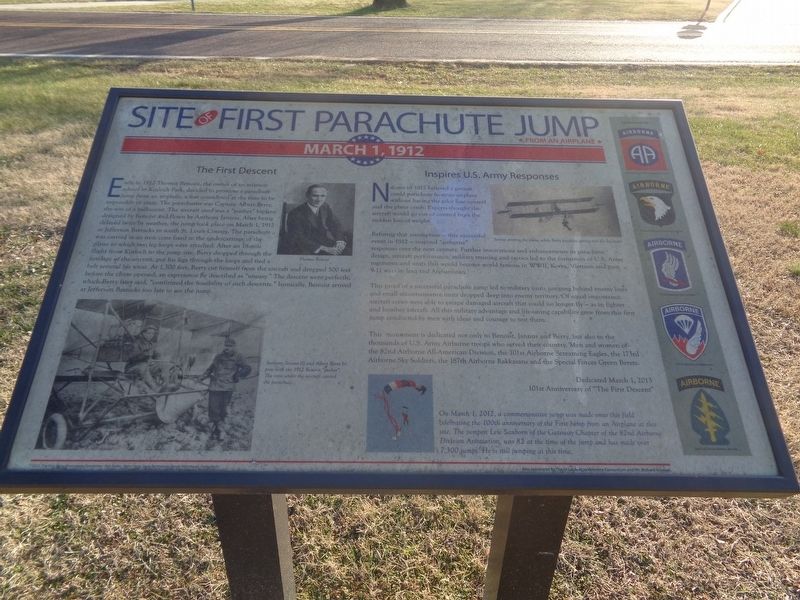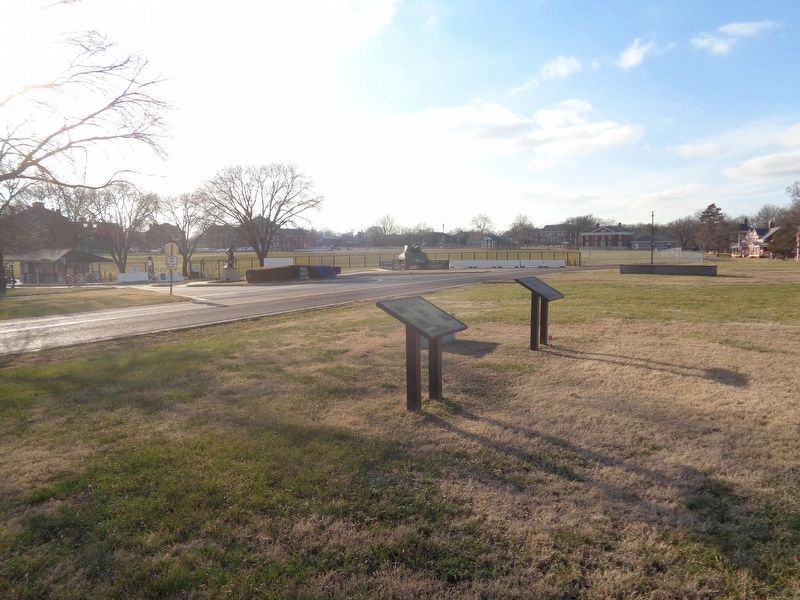Lemay in St. Louis County, Missouri — The American Midwest (Upper Plains)
Site of First Parachute Jump
March 1, 1912
The First Descent
Early in 1912 Thomas Benoist, the owner of an aviation school in Kinloch Park, decided to promote a parachute jump from an airplane, a feat considered at the time to be impossible or crazy. The parachutist was Captain Albert Berry, the son of a balloonist. The aircraft used was a "pusher" biplane designed by Benoist and flown by Anthony Jannus. After being delayed twice by weather, the jump took place on March 1, 1912 at Jefferson Barracks in south St. Louis County. The parachute was carried in an iron cone fixed to the undercarriage of the plane to which two leg loops were attached. After an 18-mile flight from Kinloch to the jump site, Berry dropped through the fuselage of the aircraft, put his legs through the loops and tied a belt around his waist. At 1,500 feet, Berry cut himself from the aircraft and dropped 500 feet before the chute opened, an experience he described as "uneasy." The descent went perfectly, which Berry later said, "confirmed the feasibility of such descents." Ironically, Benoist arrived at Jefferson Barracks too late to see the jump.
Inspires U.S. Army Responses
No one in 1912 believed a person could parachute from an airplane without having the pilot lose control and the plane crash. Experts thought the aircraft would go out of control from the sudden loss of weight.
Refuting that assumption - this unsuccessful event in 1912 - inspired "airborne" responses over the next century. Further innovations and enhancements in parachute design, aircraft performance, military training and tactics led to the formation of U.S. Army regiments and units that would become world famous in WWII, Korea, Vietnam and post 9-11 wars in Iraq and Afghanistan.
This proof of a successful parachute jump led to military units jumping behind enemy lines and small reconnaissance units dropped deep into enemy territory. Of equal importance, aircraft crews were able to escape damaged aircraft that could no longer fly - as in fighter and bomber aircraft. All this military advantage and life-saving capability grew from this first jump conducted by men with ideas and courage to test them.
This monument is dedicated not only to Benoist, Jannus and Berry, but also to the thousands of U.S. Army Airborne troops who served their country. Men and women of the 82nd Airborne All-American Division, the 101st Airborne Screaming Eagles, the 173rd Airborne Sky Soldiers, the 187th Airborne Rakkasans and the Special Forces Green Berets.
Dedicated March 1, 2013
101st Anniversary of "The First Descent"
(photo caption:)
On March 1, 2012, a commemorative jump was made onto this field celebrating the 100th anniversary
of the First Jump from an Airplane at this site. The jumper, Lew Sanborn of the Gateway Chapter of the 82nd Airborne Division Association, was 82 at the time of the jump and has made over 7,300 jumps. He is still jumping at this time.
Erected 2013 by The First Jump Monument Committee.
Topics. This historical marker is listed in this topic list: Air & Space. A significant historical date for this entry is March 1, 1912.
Location. 38° 30.362′ N, 90° 16.788′ W. Marker is in Lemay, Missouri, in St. Louis County. Marker is at the intersection of Hancock Avenue and Center Road, on the right when traveling west on Hancock Avenue. Marker is located at Jefferson Barracks Park, across the street from the Missouri National Guard area entrance. Touch for map. Marker is at or near this postal address: 1 Grant Rd, Saint Louis MO 63125, United States of America. Touch for directions.
Other nearby markers. At least 8 other markers are within walking distance of this marker. The Historic Parade Ground (here, next to this marker); WWII M4A3E8 Sherman Tank (within shouting distance of this marker); "The Tower" (about 800 feet away, measured in a direct line); U.S. Grant: The St. Louis Years (approx. 0.2 miles away); Veterans Memorial (approx. ¼ mile away); Jefferson Barracks (approx. 0.3 miles away); Killed in Action (approx. 0.3 miles away); United States Air Force (approx. 0.3 miles away). Touch for a list and map of all markers in Lemay.
Also see . . . Lew Sanborn on Wikipedia. Sanborn (born 1930) is known to be a pioneer in the parachuting sport. In 2010, he was inducted in the inaugural class of the International Skydiving Hall of Fame. (Submitted on December 29, 2020, by Jason Voigt of Glen Carbon, Illinois.)
Additional keywords. parachuting, skydive, skydiving
Credits. This page was last revised on December 29, 2020. It was originally submitted on December 29, 2020, by Jason Voigt of Glen Carbon, Illinois. This page has been viewed 239 times since then and 25 times this year. Photos: 1. submitted on December 29, 2020, by Jason Voigt of Glen Carbon, Illinois. 2. submitted on December 28, 2020, by Jason Voigt of Glen Carbon, Illinois.

